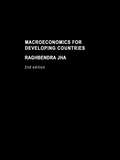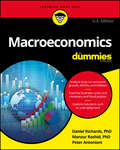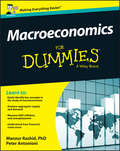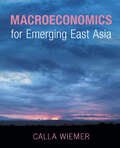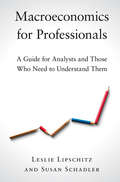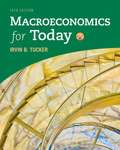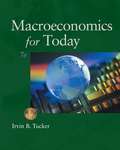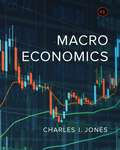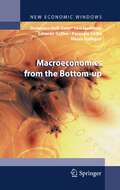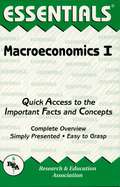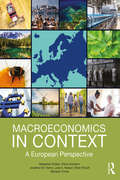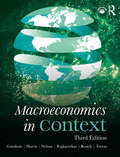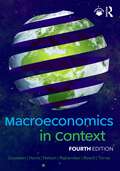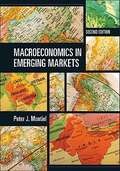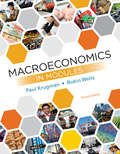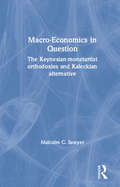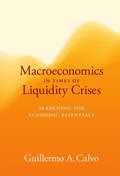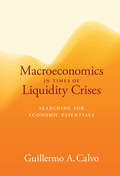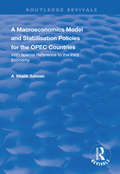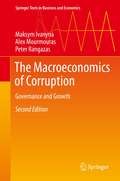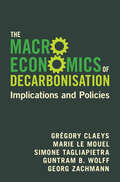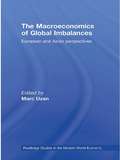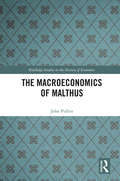- Table View
- List View
Macroeconomics for Developing Countries
by Raghbendra JhaThis comprehensively revised and updated edition develops the themes presented in the first edition. Students and teachers who are familiar with the book will notice entirely new chapters as well as significant revision and uptating of existing chapters to take into account global economic changes since the turn of the millennium. With qu
Macroeconomics For Dummies
by Dan Richards Manzur Rashid Peter AntonioniMacroeconomics For Dummies is the ideal resource for students in macro courses looking for a way to better understand and supplement their classwork. It is also perfect for readers with a general interest in expanding their general economics knowledge into the macroeconomics area. In 2011 and 2012, business was the single major with the greatest number of confirmed graduates. Macroeconomics (or a similarly named class) is a required course for every business or finance student at the college level.
Macroeconomics For Dummies - UK Edition
by Manzur Rashid Peter Antonioniifferent financial, business, consumer, and political factors interact to create the overall economic reality of nationsUnderstand business cycles, economic growth, and fiscal and monetary policiesStudy the relationships of various economic indicators, such as inflation, unemployment, and domestic outputGain a solid understanding of macroeconomics by building on microeconomic principles and using real-world examplesIf you're struggling with your economics course or you need to get up to speed on the topic of macroeconomics quickly, Macroeconomics For Dummies has you covered!
Macroeconomics for Emerging East Asia
by Calla WiemerMacroeconomics for Emerging East Asia presents a distinctive approach to the study of macroeconomic theory and policy. The author develops a unique analytical framework that incorporates: (1) both internal and external balance as aspects of macroeconomic stability; (2) both the exchange rate and the interest rate as monetary policy instruments, (3) government debt sustainability as a concern of fiscal policy, and (4) global capital flows as a force to be reckoned with. The framework provides students with the foundational knowledge to analyze macroeconomic issues common to emerging economies. Concepts are illustrated using the latest empirical data and extensive case study analysis for thirteen economies of Northeast and Southeast Asia (Cambodia, China, Hong Kong, Indonesia, Korea, Laos, Myanmar, Malaysia, the Philippines, Singapore, Taiwan, Thailand, and Vietnam). The book's lucid exposition accommodates students of differing levels of preparation.
Macroeconomics for Professionals: A Guide for Analysts and Those Who Need to Understand Them
by Susan Schadler Leslie LipschitzUnderstanding macroeconomic developments and policies in the twenty-first century is daunting: policy-makers face the combined challenges of supporting economic activity and employment, keeping inflation low and risks of financial crises at bay, and navigating the ever-tighter linkages of globalization. Many professionals face demands to evaluate the implications of developments and policies for their business, financial, or public policy decisions. Macroeconomics for Professionals provides a concise, rigorous, yet intuitive framework for assessing a country's macroeconomic outlook and policies. Drawing on years of experience at the International Monetary Fund, Leslie Lipschitz and Susan Schadler have created an operating manual for professional applied economists and all those required to evaluate economic analysis.
Macroeconomics for Today
by Irvin B. TuckerIn this book, Irvin Tucker presents Macro and Micro economic concepts using a writing style that is engaging and clear, no matter what your current level of economic understanding. A unique presentation and visual learning system, colorful graphs and Causation Chains clarify and illustrate important economic principles. The book concisely presents and reinforces core concepts, while online resources immediately facilitate assessment of understanding, and will study the latest information on economic growth, income distribution, federal deficits, environmental issues, and other developments in economics today. The book's easy-to-follow format demonstrates how to apply principles to your everyday life, while numerous printed and digital study tools help you further master key current economic principles.
Macroeconomics for Today (7th Edition)
by Irvin B. TuckerHelp today's learner visualize macroeconomics in action with the most pedagogically rich, complete book available--Tucker's MACROECONOMICS FOR TODAY, Seventh Edition. A quick look at this engaging, dynamic text will show you why this is the book that is famous for helping readers at all levels of skill and preparation grasp and master economic principles. Written by an award-winning educator, recognized for his work in relating basic economic principles to global issues, Irvin Tucker's MACROECONOMICS FOR TODAY continues its unique textual and visual learning system. This edition concisely presents and reinforces core concepts, then immediately assesses student comprehension. You will find the latest economic information on federal deficits, the stimulus package, environmental issues, and other developments presented in an engaging, easy-to-follow format applicable to everyday life. MACROECONOMICS FOR TODAY, Seventh Edition, provides a full complement of instructor resources, including a handy Instructor's Resource CD, new PowerPoint? slides, optional CourseMate website, and complete array of videos.
Macroeconomics (Fourth Edition)
by Charles I. JonesCombining innovative treatment of macroeconomic concepts with the clearest presentation of long-run growth theory, Jones offers students an accessible and truly modern introduction to the field. With new primers, important updates on the aftermath of the great recession, and over 90 updated charts and tables, Macroeconomics, Fourth Edition, is the ideal text for exposing undergraduates to current perspectives at a level they can understand.
Macroeconomics from the Bottom-up
by Saul Desiderio Edoardo Gaffeo Pasquale Cirillo Domenico Delli Gatti Mauro GallegatiThis book arose from our conviction that the NNS-DSGE approach to the analysis of aggregate market outcomes is fundamentally flawed. The practice of overcoming the SMD result by recurring to a fictitious RA leads to insurmountable methodological problems and lies at the root of DSGE models' failure to satisfactorily explain real world features, like exchange rate and banking crises, bubbles and herding in financial markets, swings in the sentiment of consumers and entrepreneurs, asymmetries and persistence in aggregate variables, and so on. At odds with this view, our critique rests on the premise that any modern macroeconomy should be modeled instead as a complex system of heterogeneous interacting individuals, acting adaptively and autonomously according to simple and empirically validated rules of thumb. We call our proposed approach Bottom-up Adaptive Macroeconomics (BAM). The reason why we claim that the contents of this book can be inscribed in the realm of macroeconomics is threefold: i) We are looking for a framework that helps us to think coherently about the interrelationships among two or more markets. In what follows, in particular, three markets will be considered: the markets for goods, labor and loanable funds. In this respect, real time matters: what happens in one market depends on what has happened, on what is happening, or on what will happen in other markets. This implies that intertemporal coordination issues cannot be ignored. ii) Eventually, it's all about prices and quantities. However, we are mostly interested in aggregate prices and quantities, that is indexes built from the dispersed outcomes of the decentralized transactions of a large population of heterogeneous individuals. Each individual acts purposefully, but she knows anything about the levels of prices and quantities which clear markets in the aggregate. iii) In the hope of being allowed to purport scientific claims, BAM relies on the assumption that individual purposeful behaviours aggregates into regularities. Macro behaviour, however, can depart radically from what the individual units are trying to accomplish. It is in this sense that aggregate outcomes emerge from individual actions and interactions.
Macroeconomics I Essentials
by Robert RycroftREA's Essentials provide quick and easy access to critical information in a variety of different fields, ranging from the most basic to the most advanced. As its name implies, these concise, comprehensive study guides summarize the essentials of the field covered. Essentials are helpful when preparing for exams, doing homework and will remain a lasting reference source for students, teachers, and professionals. Macroeconomics I includes economic problems, demand and supply, economic systems, the private sector, the public sector, gross national product, macroeconomic problems, and macroeconomic models.
Macroeconomics in Context: A European Perspective
by Sebastian Dullien Neva Goodwin Jonathan M. Harris Julie A. Nelson Brian Roach Mariano Torras<p>Macroeconomics in Context: A European Perspective lays out the principles of macroeconomics in a manner that is thorough, up to date, and relevant to students. With a clear presentation of economic theory throughout, this latest addition to the bestselling "In Context" set of textbooks is written with a specific focus on European data, institutions, and historical events, offering engaging treatment of high-interest topics, including sustainability, Brexit, the euro crisis, and rising inequality. Policy issues are presented in context (historical, institutional, social, political, and ethical), and always with reference to human well-being. This book is divided into four parts, covering the following key issues: <p> <li>The context of economic analysis, including basic macroeconomic statistics and tools; <li>The basics of macroeconomic measurements, including GDP, inflation, and unemployment, as well as alternative measures of well-being, and the particular structures of the European economies; <li>Methods for analyzing monetary and fiscal policy, including an in-depth coverage of the instruments and approaches of the European central bank and some coverage of an open economy; <li>The application of the tools learnt to selected macroeconomic issues, such as the euro crisis, the global financial crisis, public debt, global development, and environmental sustainability. </li> <p> <p>Far more than any other existing macroeconomic textbook, this book combines real-world relevance of the topics covered with a strong focus on European institutions and structures within an approach that explains multiple economic paradigms. This combination helps to raise students’ interest in macroeconomics as well as enhance their understanding of the power and limitation of macroeconomic analysis. Visit www.gdae.org/europeanmacro/ for online resources for both lecturers and students. </p>
Macroeconomics in Context: A European Perspective
by Neva Goodwin Jonathan M. Harris Julie A. Nelson Pratistha Joshi Rajkarnikar Brian Roach Mariano TorrasMacroeconomics in Context lays out the principles of macroeconomics in a manner that is thorough, up to date, and relevant to students. Like its counterpart, Microeconomics in Context, the book is uniquely attuned to economic realities. The "in Context" books offer engaging coverage of current topics including financial crises, rising inequality, debt and deficits, and environmental sustainability, while also providing a clear and accessible exploration of economic theory and applications. The third edition features: Clear explanations of basic economic concepts alongside more in-depth analysis of macroeconomics models and economic activity Expanded coverage of topics including, inequality, financialization and debt issues, the changing nature of jobs, and sustainable development Thoroughly updated figures and data A full complement of online instructor and student support materials such as additional tables and data, PowerPoint slides and a study guide This engaging textbook offers students an excellent guide to macroeconomics. The latest addition to the "In Context" series, it combines real-world relevance with a thorough grounding in multiple economic paradigms.
Macroeconomics in Context: A European Perspective
by Neva Goodwin Jonathan M. Harris Julie A. Nelson Pratistha Joshi Rajkarnikar Brian Roach Mariano TorrasMacroeconomics in Context lays out the principles of macroeconomics in a manner that is thorough, up to date, and relevant to students. Like its counterpart, Microeconomics in Context, the book is uniquely attuned to economic, social, and environmental realities. The “In Context” books offer engaging coverage of current topics including policy responses to recession and inflation, inequality, deficits and government debt, economic impacts of the COVID-19 pandemic, and the economics of environmental sustainability. This fourth edition includes: Improved and concise discussions of introductory topics, especially on key economic activities, macroeconomic goals, and economic models Further emphasis on inequality, environmental sustainability, financialization, the changing nature of work, and international developments such as the role of transnational corporations and supply chain issues Discussion of the impacts of the COVID-19 pandemic on macroeconomic factors like well-being, inequality, and labor markets Presentation of policy issues in historical, environmental, institutional, social, political, and ethical contexts, including an updated discussion of fiscal policy in relation to the Biden administration’s infrastructure and social investment spending Clear explanations of basic economic concepts alongside more in-depth analysis of macroeconomics models and economic activity This book combines real-world relevance with a thorough grounding in multiple economic paradigms. It is the ideal textbook for modern introductory courses in macroeconomics. The book’s companion website is available at: http://www.bu.edu/eci/macro
Macroeconomics in Context: A European Perspective
by Jonathan Harris Neva Goodwin Julie A. Nelson Brian Roach Mariano TorrasMacroeconomics in Context lays out the principles of macroeconomics in a manner that is thorough, up to date, and relevant to students. Like its counterpart, Microeconomics in Context, the book is attuned to economic realities--and it has a bargain price. The in Context books offer affordability, engaging treatment of high-interest topics from sustainability to financial crisis and rising inequality, and clear, straightforward presentation of economic theory. Policy issues are presented in context--historical, institutional, social, political, and ethical--and always with reference to human well-being.
Macroeconomics in Ecological Context
by Karl SeeleyNatural resources have been a recurring subject of public interest, from the environmental awakening in and the oil crises of the later 20th century, to wide swings in oil prices and increased concern about climate change in the first decades of the 21st century. Standard macroeconomics books treat resources in passing, in an ad hoc manner, if at all. This text integrates resources into the model from the ground up, allowing a more logically consistent understanding of the economic effects of changed resource availability. But the underlying structure remains mostly traditional: a full-employment perspective on the long run and a Keynesian approach to business-cycle fluctuations. This provides an easier adaptation for instructors and gives students the tools to understand economic analysis done in a more conventional framework. The business-cycle material starts with a "natural history" of money to help students see the connections between social and physical phenomena.
Macroeconomics in Emerging Markets
by Peter J. MontielThe macroeconomic experience of emerging and developing economies has tended to be quite different from that of industrial countries. Compared to industrial countries, emerging and developing economies have tended to be much more unstable, with more severe boom/bust cycles, episodes of high inflation and a variety of financial crises. This textbook describes how the standard macroeconomic models that are used in industrial countries can be modified to help understand this experience and how institutional and policy reforms in emerging and developing economies may affect their future macroeconomic performance. This second edition differs from the first in offering: extensive new material on themes such as fiscal institutions, inflation targeting, emergent market crises, and the Great Recession; numerous application boxes; end-of-chapter questions; references for each chapter; more diagrams, less taxonomy, and a more reader-friendly narrative; and enhanced integration of all parts of the work.
Macroeconomics in Modules
by Paul Krugman Robin WellsAdapted by Paul Krugman and Robin Wells from their bestselling macroeconomics textbook, Macroeconomics in Modules is the only text for the principles of macroeconomics course organized in the supremely accessible, highly effective modular format. Instead of chapters of standard length, the book covers the fundamentals of macroeconomics in 49 brief (4-10 page) modules divided into 14 sections. Macroeconomics in Modules offers the best of what makes Krugman/Wells a classroom favorite (story-telling approach, engaging writing, fascinating examples and cases), in a format students and instructors will love. Extensive educational research shows that students absorb more from shorter reading assignments than longer ones. And with coverage in self-contained modules, instructors can assign specific topics without asking students to read entire chapters.
Macroeconomics in Question: The Keynesian-Monetartist Orthodoxies and Kaleckian Alternative
by Malcolm C. SawyerOriginally published in 1982, this book has two central purposes. The first is to present a rather more critical view of the Keynesian and monetarist approaches to macro-economics than is usually found in major macro-economics text-books. The second is to present an alternative approach to macro-economics, derived in the main from the work of Michal Kalecki. It will become apparent below that the major difference between the conventional approaches to macro-economics and the Kaleckian one arises from a basic difference over the nature of a modern capitalist economy. The conventional approaches rest on a perfectly competitive view of the world whilst the Kalecki approach draws on an oligopolistic view. The book has been written to be accessible to undergraduate students of economics who have taken a basic second-year degree level course in macro-economics (as represented by text-books such as Branson, 1979; Gordon, 1981). Particularly in Chapters 2-4 a knowledge of conventional macro-economics is required. References are provided in the text and in footnotes for those wishing to pursue particular topics further. The book also contains much of interest for professional economists.
Macroeconomics in Times of Liquidity Crises: Searching for Economic Essentials
by Guillermo A. CalvoSince the subprime mortgage crisis that began in 2007, advanced economies have felt a nagging sense of insecurity. In parallel, the profession has witnessed phenomena that are alien to mainstream macroeconomic models. Financial crises are systemic, occurring simultaneously in different economies. In this book, Guillermo Calvo focuses on liquidity factors as a commonality in financial crises. Specifically, he examines the role of "liquidity crunch" in triggering crises. He also identifies a fundamental (but overlooked) idea in Keynes's General Theory, termed by Calvo the price theory of money, to rationalize the resiliency of the U.S. dollar when other dollar-backed assets suffered a devastating liquidity crunch.Calvo shows that a sharp focus on liquidity reveals some characteristics of liquid assets that are easy to miss otherwise. He argues for liquidity's centrality, presenting what he calls the Liquidity Approach. He shows that simple extensions of standard monetary models help rationalize the implications of the liquidity crunch, and then examines slightly more technical models that highlight liquidity issues. He explores the empirical effects of liquidity crunch by studying systemic sudden stops (of capital inflows), presuming that they are triggered by liquidity crunch-type phenomena.
Macroeconomics in Times of Liquidity Crises: Searching for Economic Essentials (Ohlin Lectures)
by Guillermo A. CalvoAn examination of Liquidity Crunch in triggering and characterizing financial crises.Since the subprime mortgage crisis that began in 2007, advanced economies have felt a nagging sense of insecurity. In parallel, the profession has witnessed phenomena that are alien to mainstream macroeconomic models. Financial crises are systemic, occurring simultaneously in different economies. In this book, Guillermo Calvo focuses on liquidity factors as a commonality in financial crises. Specifically, he examines the role of “liquidity crunch” in triggering crises. He also identifies a fundamental (but overlooked) idea in Keynes's General Theory, termed by Calvo the price theory of money, to rationalize the resiliency of the U.S. dollar when other dollar-backed assets suffered a devastating liquidity crunch.Calvo shows that a sharp focus on liquidity reveals some characteristics of liquid assets that are easy to miss otherwise. He argues for liquidity's centrality, presenting what he calls the Liquidity Approach. He shows that simple extensions of standard monetary models help rationalize the implications of the liquidity crunch, and then examines slightly more technical models that highlight liquidity issues. He explores the empirical effects of liquidity crunch by studying systemic sudden stops (of capital inflows), presuming that they are triggered by liquidity crunch-type phenomena.
A Macroeconomics Model and Stabilisation Policies for the OPEC Countries: With Special Reference to the Iraqi Economy (Routledge Revivals)
by A. Khalik SalmanFirst published in 1999, this book focuses on the macroeconomics issues which directly affect OPEC countries, aiming to set them in the context of the overall development effort. The most extant theoretical and empirical aspects in macroeconomics are integrated smoothly with institutional issues and policy questions. The analysis is illustrated through examples to show how the theories relate to the real world, especially to ongoing debates on developing economies as well as debates that encompass both developing and OPEC and developed countries.
The Macroeconomics of Corruption: Governance and Growth (Springer Texts in Business and Economics)
by Maksym Ivanyna Alex Mourmouras Peter RangazasThis textbook examines corruption through a macroeconomic lens, exploring the relationship between corruption, fiscal policy, and political economy. It merges macroeconomic growth models with elements of political economic theory to address important applied topics such as income inequality within and across countries, growth slowdowns, and fiscal crises. Revised and updated to include new research findings and recent policy discussions, the second edition contains 15 new sections and 2 new chapters on topics such as public defaults, the wage elasticity of work and the interest elasticity of saving, and the economic and fiscal impact of the 2020 pandemic. Most of the basic ideas are illustrated using a two-period model of government investment that captures the future cost of policies that favor the present. The more subtle and advanced issues are illustrated and, in some cases, quantified, using the overlapping-generations model of economic growth. The models used to illustrate the mechanisms of economic growth are extended to incorporate politics and the behavior of public official. The text concludes with a thorough discussion of policy reforms designed to address the issues discussed in earlier chapters. Intended for students familiar with intermediate-level economics, the second edition contains a technical appendix, expanded end-of-chapter questions and problems, and a complete solutions manual. The second edition also offers updated resources for instructors, including sample syllabi and over 550 multiple choice questions. Offering a unified explanation for the causes and consequences of government failure, fiscal crisis, and needed policy reforms, this text is appropriate for advanced undergraduate and beginning graduate courses in macroeconomics, political economy, and public policy.
The Macroeconomics of Decarbonisation: Implications and Policies
by Grégory Claeys Marie Le Mouel Simone Tagliapietra Guntram B. Wolff Georg ZachmannDecarbonisation is the reduction of carbon dioxide emissions using low carbon power sources, lowering output of greenhouse gasses into the atmosphere. This is essential to meet global temperature standards set by international climate agreements. To limit global warming to 1.5°C, hence avoiding the worst-case scenarios predicted by climate science, the world economy must rapidly reduce its emissions and reach climate neutrality within the next three decades. This will not be an easy journey. Shifting away from carbon-intensive production will require a historic transformation of the structure of our economies. Written by a team of academics linked to the European think tank Bruegel, The Macroeconomics of Decarbonisation provides a guide to the macroeconomic fundamentals of decarbonisation. It identifies the major economic transformations, both over the long- and short-run, and the roadblocks requiring policy intervention. It proposes a macroeconomic policy agenda for decarbonisation to achieve the climate goals of the international community.
The Macroeconomics of Global Imbalances: European and Asian Perspectives (Routledge Studies in the Modern World Economy)
by Marc UzanThis book is the result of a workshop on the effects of globalization on Asian and European countries, organized by Marc Uzan and the Austrian Ministry of Finance in April 2006. Bringing together key academics, policy makers and private market participants, these chapters cover the current debate of global imbalances and the way to resolve the disequilibrium in the international monetary system and understand the need for international cooperation among the different monetary areas of the world. Various important points come out of the book; firstly there is an emphasis on the difficulties for Europeans and Asians to find common positions vis-à-vis global imbalances due to different exchange rate regimes throughout Asia preventing similar responses. The role of the US dollar as a world currency is also discussed, as well as EU regional monetary cooperation and an analysis of the Euro. The implementation of economic policy to redress global imbalances is also considered, as is the emergence of China on the world stage and its industrial development projects. These questions and the way the international financial community will resolve them, will have a huge impact in the functioning of the international monetary system. The current unwinding of the global imbalances that we are facing with the global market disruptions since August 2007, demonstrate that a new geography of international finance is emerging between Europe and Asia. The book addresses also the way that a dialog in the field in monetary arena needs to be structured between Europe and Asia.
The Macroeconomics of Malthus (Routledge Studies in the History of Economics)
by John PullenThe views of Thomas Robert Malthus (1766–1834) on population, first published in his Essay on the Principle of Population, 1798, continue to be hotly debated, either acclaimed or opposed, as do his views on macroeconomics. There is a widely held view that his macroeconomics lacks coherence and is merely a collection of isolated jottings. This book challenges this view; it presents textual evidence that Malthus’s macroeconomics constitutes a significant system of thought with considerable academic merit. It reawakens debate about the relative merits of Malthus and Ricardo as macroeconomists and contends that Malthus offers important macroeconomic ideas and policy proposals relevant to modern economic problems. It presents and analyses Malthus’ ideas on topics such as the determinants of aggregate economic growth; the causes of general depression; the remedies for mass unemployment; the balance between laissez-faire and government intervention; the optimum division of expenditure between consumption, saving, and investment; the distribution of income between wages, profits, and rents; and the degree of economic inequality. Particular emphasis is given to his view that the pattern of distribution of wealth between the upper, lower, and middle classes is a major determinant or factor in the production of wealth, and that continued economic development depends on the growth of a large and affluent middle class. The radical nature of some of his ideas and policy proposals on the ownership and distribution of land is highlighted. An extensive treatment of Say’s Law, incorporating aspects of the correspondence between Say and Malthus, addresses the question of whether Malthus showed that Say’s Law is merely a truism and lacks any scientific relevance. The book also sheds new light on the nature of the influence of Malthus on Keynes. This combination of a search for textual authenticity and a critical assessment of the views of commentators on Malthus will be of significant interest to students and scholars of economic theory and the history of economics.
